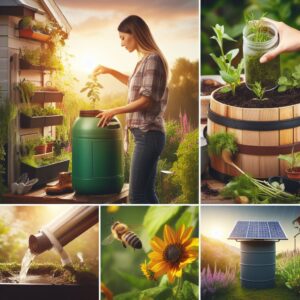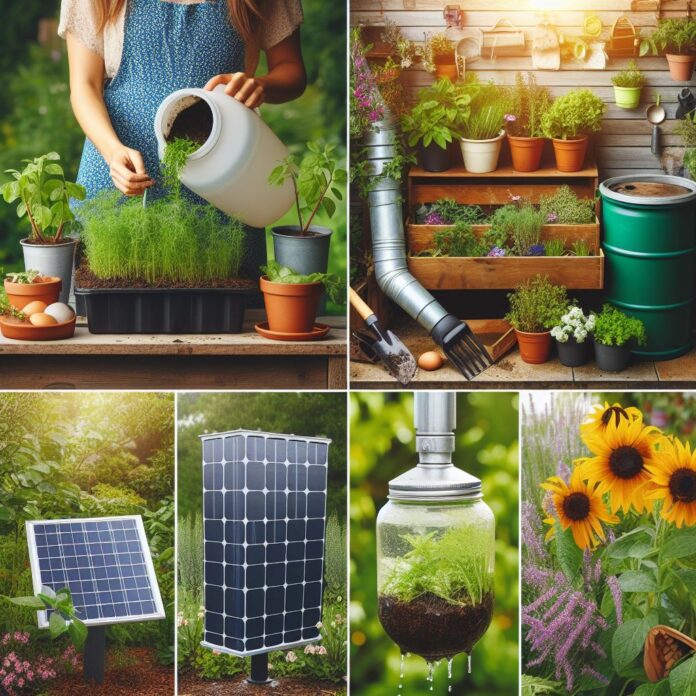In the blossoming world of gardening, eco-friendliness isn’t just a trend – it’s a crucial shift towards sustainable, earth-friendly practices. Home gardeners are uniquely positioned to contribute positively to the environment through small, but significant changes in their approach to tending the earth. This guide is a call to action for the eco-conscious – it’s time to take our gardening from green to truly eco-friendly.
Eco-Friendly Gardening
One of the most impactful ways to cultivate an eco-friendly garden is by adopting sustainable watering practices that conserve water while ensuring your plants thrive. The principle of using water efficiently in the garden goes beyond merely reducing consumption—it involves a series of practices and innovations that can significantly mitigate the environmental impact of gardening. For instance, installing a rainwater harvesting system can provide you with an eco-friendly water source that reduces dependency on municipal supplies. Utilizing soaker hoses or drip irrigation systems targets water directly to the roots of plants, minimizing wastage through evaporation and runoff. Another practice is mulching, which retains moisture in the soil, reduces water evaporation, and also suppresses weed growth, thereby cutting down the need for both water and chemical herbicides. Additionally, choosing native plants that are adapted to your local climate can drastically lower water demand because these species are naturally equipped to thrive in their native habitat’s conditions. By integrating these sustainable watering techniques, gardeners can create lush, productive gardens that are in harmony with the ecosystem, demonstrating that responsible water management is both a necessary and attainable goal in the quest for sustainability.

1.The Importance of Eco-Friendly Gardening
Before we plunge into the practical tips, it’s important to understand why eco-friendly gardening matters. In a time when climate change and biodiversity loss are urgent global concerns, the way we manage our home gardens can make a real difference. Local habitats provide essential food and shelter for birds, bees, and other wildlife that might otherwise struggle to find a safe place to survive. By making our gardens more sustainable, we create micro-ecosystems that can serve as havens for these creatures, helping to bolster overall biodiversity.
1. Promoting Biodiversity in your Backyard
Biodiversity is critical to the health of our planet, and home gardens play a pivotal role in supporting local ecosystems. Planting a variety of native species can attract a diverse range of beneficial insects and wildlife, naturally providing the balance needed to keep any one species from overwhelming the others.
2. Reducing Environmental Impact
Eco-friendly gardening techniques can significantly reduce the environmental impact of garden maintenance. From lowering water usage to minimizing chemical runoff into waterways, each eco-conscious decision adds up to a healthier environment.
3. Setting a Positive Example
By adopting sustainable practices in our gardens, we also set a positive example for our community, friends, and family. Sharing the benefits and beauty of an eco-friendly garden can inspire others to make similar changes in their own green spaces.
2.Getting Started with Eco-Friendly Gardening
Transitioning to eco-friendly gardening doesn’t have to happen all at once. It’s a step-by-step process that can be integrated gradually. Here’s how you can begin your eco-friendly garden from scratch or transition your current garden to be more sustainable.
1. Understand Your Local Ecosystem
The first step to an eco-friendly garden is learning about the plants, insects, and wildlife that are native to your area. Native plants are adapted to local conditions, such as soil type and climate, and support native wildlife.
2. Reduce Water Usage with Smart Irrigation
Overwatering is a common issue in traditional gardening that wastes water and can be harmful to plants. Smart irrigation techniques like drip systems and rain barrels can reduce water consumption and ensure that plants get the right amount of moisture.
3. Say No to Chemicals
Chemical pesticides and fertilizers can have detrimental effects on surrounding ecosystems. Switch to natural pest control methods like companion planting, which involves grouping plants that benefit each other, or using organic fertilizers like compost.
3.Sustainable Garden Design
When designing your garden, think about how to incorporate sustainable practices that will make maintenance easier and reduce the need for additional resources.
1. Plan for Perennials
Perennial plants come back year after year, reducing the need to replant and preserving soil structure. They also provide habitats for wildlife and can make your garden more low-maintenance.
2. Use Permaculture Principles
Permaculture is a gardening and design system that works with natural processes. It involves creating systems that are self-sustaining and can be a guiding principle for your garden’s layout and maintenance.
3. Choose Materials Wisely
From the type of mulch you use to the paving stones in your garden path, each material has an environmental impact. Opt for sustainable materials like reclaimed wood or sustainably sourced stone.
4.Eco-Friendly Maintenance
Once your garden is planted, it’s important to maintain it in a way that supports the environment and minimizes the use of resources.
1. Compost Waste
Composting is a simple and effective way to recycle kitchen scraps and yard waste. It provides a free source of rich soil amendment and reduces the amount of organic waste that goes to landfills.
2. Manage Weeds Sustainably
Chemical weed killers can harm the environment and create imbalance in your garden. Try mulching to suppress weeds, or hand-pull them before they go to seed.
3. Encourage Natural Pest Predators
Many insects and small animals are natural predators to common garden pests. By creating habitats for these animals, like insect hotels or small wildlife ponds, you can help keep pest populations in check without the need for harmful chemicals.
5.Enhancing Wildlife in Your Garden
A truly eco-friendly garden is one that is alive with the sounds and sights of wildlife.
1. Create Habitat for Wildlife
Birdhouses, bee hotels, and bat boxes are all simple ways to provide shelter and breeding sites for local wildlife. You can also add plants that provide food for butterflies and caterpillars.
2. Provide Water Sources
A small pond or bird bath can be a lifeline for birds and other wildlife, especially in urban areas where natural water sources may be scarce.
3. Enjoy the Rewards
The presence of wildlife is one of the greatest joys of an eco-friendly garden. Sit back and enjoy the show as your garden comes to life with the buzzing of bees, the flitting of butterflies, and the songs of birds.
For those eager to take their eco-friendly gardening to the next level and adapt their practices throughout the changing seasons, “Growing Green: Your Ultimate Gardening Calendar Guide” is an invaluable resource. This comprehensive guide offers tips and advice on how to keep your garden thriving year-round, with specific recommendations for plant care, pest management, and soil health tailored to each season. Whether you’re a seasoned gardener or a green-fingered newbie, this guide will help you plan and maintain a sustainable garden that supports local wildlife and ecosystems. Eco-Friendly Gardening to explore further, visit Growing Green: Your Ultimate Gardening Calendar Guide and see the future of eco-friendly gardening unfold.
6.Harvesting From Your Eco-Friendly Garden
When it comes time to harvest the fruits of your labour, keep sustainability in mind.
1. Preserve Your Bounty
Canning, freezing, and root cellaring are all traditional methods of preserving food that can help reduce food waste and allow you to enjoy your homegrown produce year-round.
2. Share Surplus with Others
If you find yourself with more produce than you can use, consider sharing it with friends, family, or local food banks. It’s a great way to build community and reduce waste.
3. Learn From Each Harvest
Gardening is a continuous learning process. Keep a journal of what worked well and what didn’t in each growing season, and use that knowledge to make your garden even more sustainable in the future.
Gardeners’ World Magazine offers a section on ethical and green gardening tips at Gardeners’ World
- The Royal Horticultural Society provides guidance on sustainable gardening practices at RHS
Exploring these resources can provide gardeners with a solid foundation in eco-friendly practices and inspire new projects and improvements within their green spaces.
Conclusion: Your Role in the Eco-Friendly Gardening Movement
As a homeowner with a patch of earth to call your own, you have a unique opportunity to participate in a global movement towards a more sustainable future. By making thoughtful choices Eco-Friendly Gardening in the way you design, plant, and maintain your garden, you can create an oasis of sustainability that supports the environment and contributes positively to the health of our planet.
Eco-friendly gardening is not just a checklist of sustainable tasks; it’s a mindset that values the interconnectedness of all living things and the role we play in that complex web. Each choice you make in your garden, from the plants you select to the way you water them, has the potential to ripple out and create a world that is more in harmony with nature.
The transition to an eco-friendly garden may be gradual, but with each eco-conscious decision, you’re one step closer to a garden that not only sustains itself but also contributes to a greater environmental good. Start small, and watch as your sustainable practices grow into something truly remarkable – a garden that’s alive, vibrant, and in sync with the natural world.


